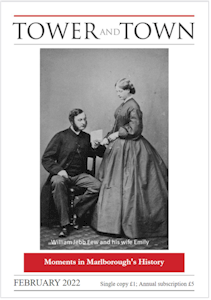

Tower and Town, February 2022 (view the full edition) (view the full edition)What's In A Name? A Short HIstory Of St John's CloseSt John's Close Marlborough - a peaceful development of 28 terraced and semi-detached houses at the top of Hyde Lane and close to the Common. What is its history? Why the name? Which St John? Why a "Close"? Early in the 13th century there was a religious house known as the Hospital of Saint John the Baptist in The Parade, then known as The Marsh, held under a 1215 Charter granted by King John. The hospital appears to have thrived throughout the Middle Ages, but fell foul of the Dissolution of Monasteries under Henry VIII, and became the property of the Crown. After Henry's death the Mayor and Corporation petitioned Edward VI to allow them to convert the hospital, which by now held the land known as St John's Close, into a Free School. The petition was granted in 1550; Marlborough's Free Grammar School was founded, and the first building of what eventually became St John's School was erected on the site in about 1577. The Close remained an asset of the Grammar School until the late19th century, let out for grazing. Other than that there is little information, although Land Tax records of 1806 intriguingly describe it as "a close of meadow or pasture land called St John's Close or Gallows' Close". The last years of the 19th century were a difficult period for the Grammar School. Numbers of pupils had declined, and the school was forced to close in 1899 prior to being rebuilt on the same site and re-opening in 1904. Meanwhile some of its assets were sold off. St John's Close was purchased by three Marlborough College masters - Henry Richardson, Granville Sharp, and Herbert Leaf. Their ambition was to improve the very poor standard of housing in the town. They agreed between them how to develop the land, and that each would retain a third of the properties. This was an age of great reform in housing. In the last two decades of the 19th century several major industrialists set out to provide better housing for their workers. It was an age that also produced the social reformer Ebenezer Howard, who in the 1890's developed the concept of the Garden City. In 1899 the Garden City Association was formed. By 1902 Howard was able to proceed with his first garden city, at Letchworth in Hertfordshire. Howard's vision covered the overall structural planning, and with his lead architect Barry Parker he established more detailed criteria: lower density; individual gardens; maximisation of sunshine; privacy; an area of communal land for leisure, or as allotments, and where people could meet and socialise. Get these right, argued Howard, and a contented, healthy and harmonious community should ensue. Richardson, Sharp and Leaf, clearly aware of this movement, laid out plans for the Close embodying all Howard and Parker's criteria, and even copied the design of some Letchworth houses. Building commenced in 1907/8, and by the 1911 Census virtually all the houses were complete and occupied. As the 20th century progressed some houses were sold into private ownership. Herbert Leaf, the last survivor of the three, died in 1936. In his will he left substantial legacies both to the town and to Marlborough College. He also left eleven cottages, including 7 in St John's Close, to the Town Council. These became public housing, although a few have now passed into private ownership. Improvements have been carried out to most of the houses; bathrooms were added to many of the dwellings only as recently as the 1960's. Most new building work has adhered to the style of the original Arts & Crafts concept, and the character remains. The result is a mix of owner-occupied and tenanted housing suitable for families, for single people and couples, leading to a balanced community such as envisaged by Ebenezer Howard over a century earlier. In 2019 the Town Council released an allotment for use as a Community Garden, and with their support the community has transformed this into a space of beauty, with a lawn, beds of flowers and herbs, shrubs, and a seating area with table and chairs. The garden has become the focus for various gatherings, al fresco meetings, and social events. The full benefit of it was realised during the lockdown phases of the pandemic; when regulations permitted hardly a day passed without a small, socially distanced group in the garden, sustained by coffee, cake, and laughter. Howard and Parker would have approved. With special thanks to my neighbours Betty Dobson and Jo Payne for their help and contributions. The original, fuller version of Dick Whitfield's article was published in the Marlborough Journal of the Merchant's House in December 2021. The Editor of Tower and Town is most grateful to The Merchant's House for permission to publish this specially abridged version here. Dick Whitfield |